Charlotte’s Strategic Mobility Plan has momentum. Here’s the latest
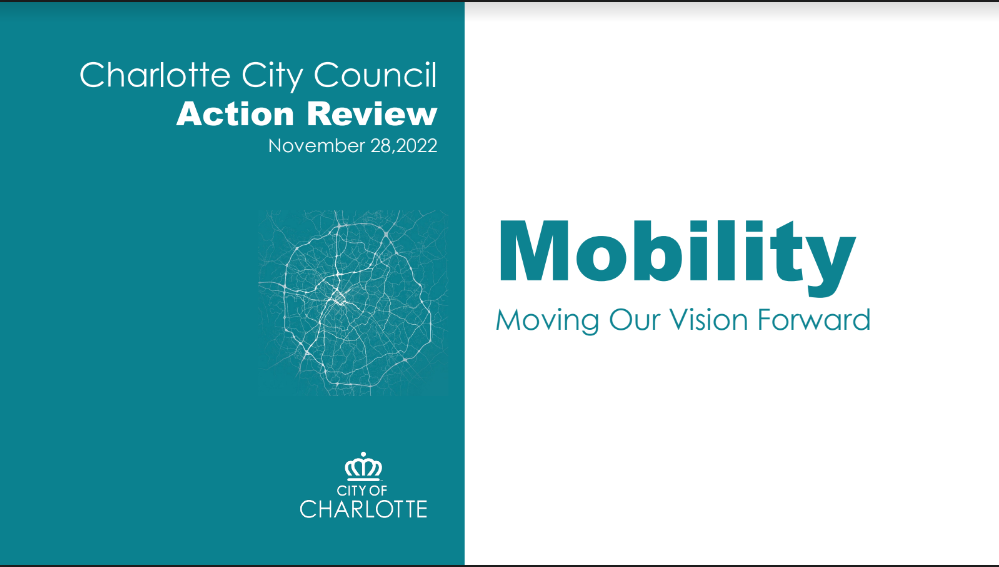
At Monday night’s City Council strategy meeting, City Manager Marcus Jones and Ed McKinney with Charlotte Department of Transportation updated Council members on plans to implement the Strategic Mobility Plan.
Jones opened his comments acknowledging that there has been much talk around public transit (rail and bus) and not enough about other forms of sustainable transportation, like sidewalks, bike paths and greenways.
McKinney helped introduce both transit and additional transportation options to the broader conversation with an extensive mobility presentation, touching on where the city has been and where it wants to go as we face tremendous growth in the coming years.
He began by applauding the five instrumental plans and policies adopted in the five years since 2018 that will dramatically shift the way that Charlotte makes transportation policy and investment decisions moving forward: The Charlotte Future 2040 Comprehensive Plan, the 2040 Policy Map, the Unified Development Ordinance, the Strategic Energy Action Plan, and the Strategic Mobility Plan.
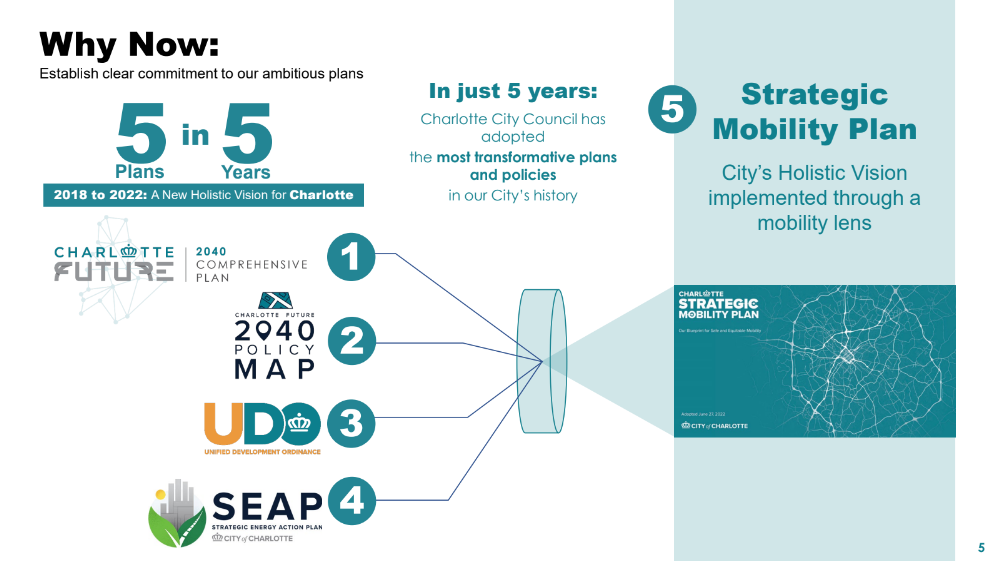
We agree with McKinney. These plans and policies are incredibly important for growing the city equitably and sustainably. This is why we have been very engaged and worked hard to engage residents in the development and adoption of each of them.
Next he touched on the city’s aspirations to ensure and prioritize the safety of all people who share Charlotte’s streets, balance our mobility choices and transition away from car dependency, make transit a natural part of how we travel, and be on the leading edge of the ongoing technological transformation when it comes to mobility.
“If we want to be equitable, we can’t have residents relying on moving by car,” McKinney said. “That notion and focus on automobiles puts residents at a disadvantage to be successful. Today, we move in a way that is predominantly a single person in a single car. The stress on our infrastructure is significant and privileges the ability to move by a car. If we can move that mobility in a way that moves to equity in modes, it will lead to a really important strategy for how we move with growth in our city.”
He touched on projects completed or in the works that will contribute to achieving these stated goals, things like the LYNX Blue Line light rail, transportation bonds recently approved by voters, the Connect Beyond regional mobility plan, and the proposed Transformational Mobility Network.
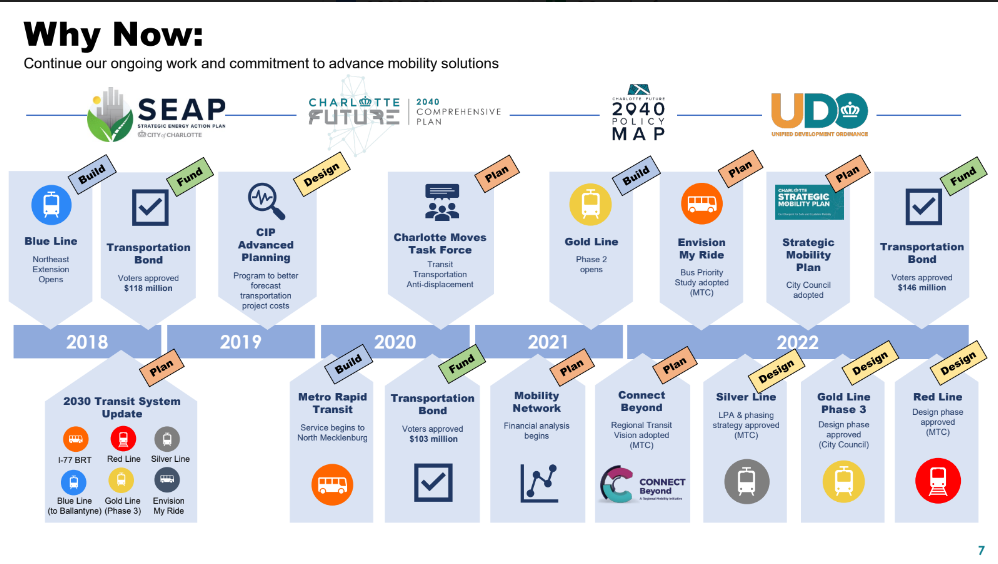
McKinney stressed the importance of taking action now to take advantage of the funding partnerships available (including major opportunities for federal funding that requires a local match) as well as the critical role that a regional approach will play in seeing any of the plans to fruition.
“We can’t do it alone,” he said. “It’s important to remember that we’re all connected. Fifty percent of folks who work in Mecklenburg County live outside of the county. This has transportation impacts for us and how we think about our regional partnerships. We are part of a system.”
He also acknowledged the mobility challenges we face. Today’s 1 million daily trips by car are predicted to double in the next 20 years. Imagine twice as much traffic on our streets! This has major implications for the decisions we make today on land use and transportation on a citywide scale.
“The notion that we can solve that problem project by project or corridor by corridor won’t be a successful endeavor,” he cautioned.
McKinney then focused on moving from aspirational to practical by following the tenets of the Charlotte Future 2040 Comprehensive Plan when it comes to long-term decisions about land use and transportation. This means coordinating land use planning with transportation investments in our bicycle network, pedestrian walkability, greenway network, bus system and rapid transit. It also requires changes to our roadway network to make streets safer and better connected for people who walk, bike, and ride transit.
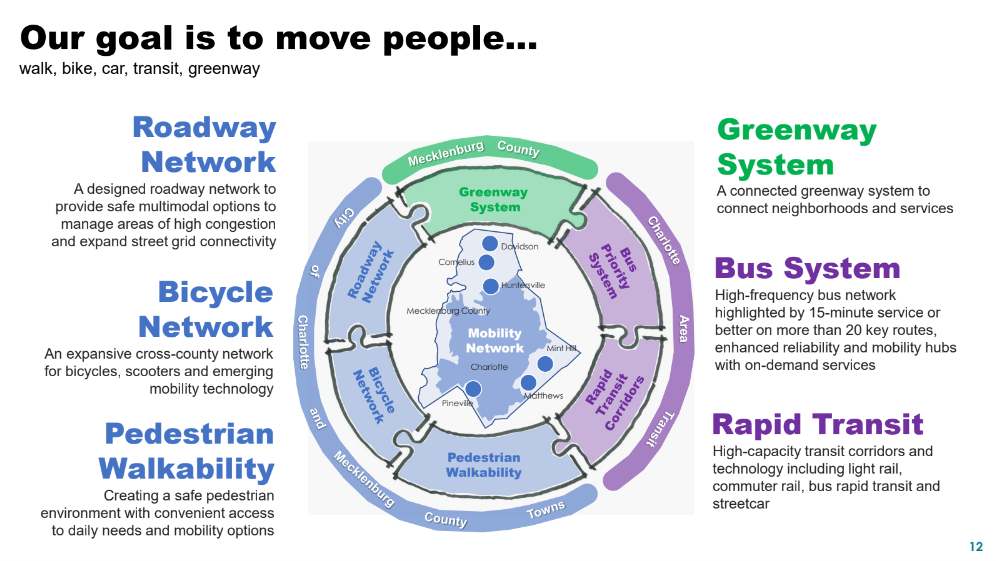
“It’s not just about rail,” he said. “It’s about how we connect into neighborhoods across the city and in partnership with the county and surrounding communities.”
It’s also, he said, about capitalizing on advances in technology and the fiber network that’s been invested in and installed over the past decade or so. Ultimately, this will play a critical role in managing all modes of transportation.
McKinney touched briefly on costs and feasibility of proposed transportation projects, acknowledging the unknowns, like inflation and cost of borrowing, that might play into expenditures.
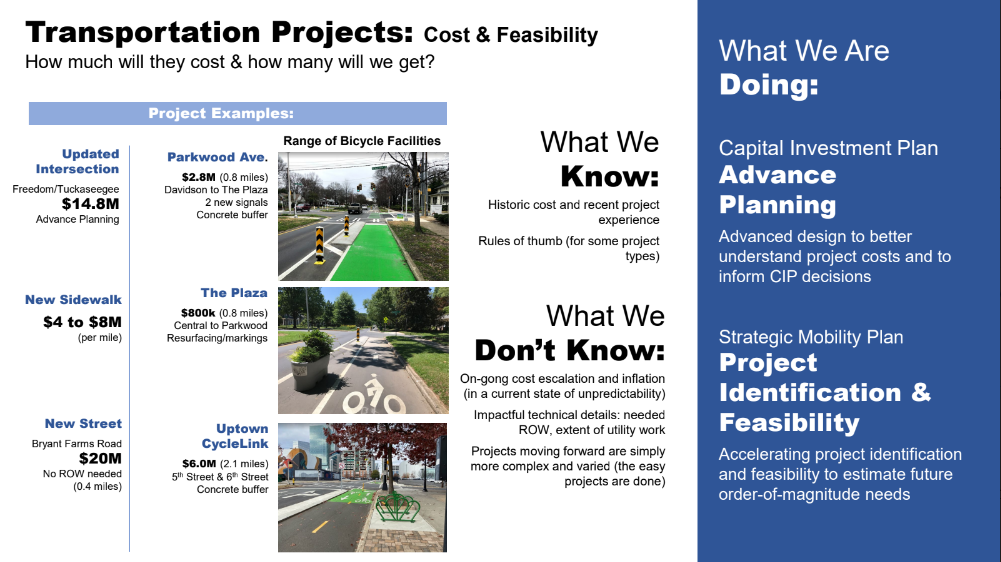
McKinney closed his part of the presentation with an overview of the project prioritization strategy. It starts with the vision and goals set forth by the city’s recently adopted plans, which drive how the potential projects are identified and assessed for feasibility based on mobility criteria.
He also touched briefly on the limitations of the 2024-28 Capital Investment Plan and potential expenditures (reduced operating funds and a change in the bond allocation mix) versus revenue (local property tax and county sales tax).
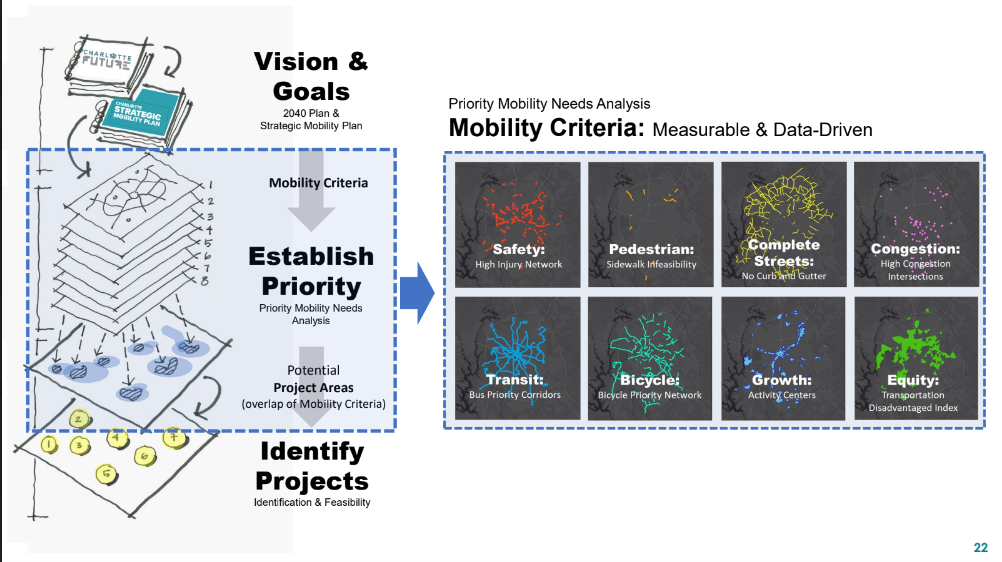
City Manager Jones concluded the presentation reminding council members that mobility is a three-legged stool, along with housing and jobs.
“We haven’t spent enough time talking about non-transit mobility options, and tonight is the beginning of that discussion,” Jones said.
Council members respond
Following the presentation, council members were each given the opportunity to make comments and ask questions. Here’s what each had to say, in their own words.
Mayor Vi Lyles
“This is a billion-dollar problem. What is the cost of only doing what we can afford? I’d like to see what other communities are measuring when it comes to whether infrastructure maintenance is an issue – all of these things we’ve talked about for so long. What is the cost of doing just what we can afford to do? Or is there an opportunity to measure what the cost would be if we grew our city with transportation options?”
Mayor Pro-Tem Braxton Winston (at large)
“I’m looking forward to figuring out the budget. There is one glaring omission we need to address in our conversation going forward. Our goal is to move people, but Charlotte is built and sustained by moving both people and goods and items. We must consider moving goods, even if they aren’t moving to the Charlotte area but through Charlotte.”
Council member Dimple Ajmera (at large)
“I thought this was a great presentation. I especially like how it ended with numbers because that’s where the rubber meets the road. If we don’t have the funding, it’s just a plan. We need to figure out next steps here in terms of increase in un-programmed capacity. What is left after we account for increased Capital Investment Plan (CIP) dollars? After factoring in an increased cost of borrowing, what does that number look like?
“I agree with my colleagues about street lights and sidewalks in order to encourage folks to take light rail. I firmly believe that private investment follows the investments we make in public infrastructure. The light rail has gotten so much time and attention. We need to focus on other mobility areas: sidewalks, bike lanes, street lighting and other safety measures to get from point A to point B — items that need to be addressed in the short term.
“A common theme in every zoning meeting is infrastructure: congestion and lack of sidewalks. Thirty-eight million dollars is not going to cover the gaps in short-term needs we have today. I would like to focus on expenditures and figure out ways to increase our capacity.”
Council member LaWana Mayfield (at large)
“As we’re having our conversations, it would be helpful if we had an equity transportation index. That might give us an idea of some of the challenges that have come from redirecting and relocating previous routes. I agree with Mr. Winston on the concern about moving products as well as people. And, it’s great to move toward a more mobile society, but not everyone has a smartphone with apps to gain access to transportation options or a bank account to use a card. Many people rely on cash and money orders. Barriers to access due to these challenges could create a potential divide. We shouldn’t make an assumption that everyone has the ability to cover the gap of the last half-mile.”
Council member Dante Anderson (District 1)
“I echo the sentiments of my colleagues that it’s a good presentation with a comprehensive approach versus a hit here, hit there, which I appreciate. I also appreciate that we’re prioritizing mobility investment through an equity lens. One thing that would be helpful as we prioritize 200 potential projects is to see where there is overlap between things like public safety issues and other things we need. That will inform how we can get our biggest bang for the buck.
“Also, given that we’re in an environment where the municipal cost index is high and in an inflationary period, buying power is lower, it would be in our interest to see where industries might not be hit as hard to get more buying power.”
Council member Malcolm Graham (District 2)
“This presentation is a keeper. It’s a really good document. I agree that we need to explore how we fund it. If we pick winners and losers by looking at projects and not the big picture, then we’re going down a lane that might not be beneficial for the long term. Behavioral change starts when transportation is safe, reliable and dependable and that starts with the bus system. And then there’s the regionalism — we can’t do this alone. What happened to the infrastructure dollars from the federal government? How are we going to utilize those for infrastructure needs?
“One thing for certain: We can’t stop the growth — the regional growth — so our approach needs to be regional in scope. How do we connect with the [North Carolina Department of Transportation] in a meaningful way? And the federal government. How do we have a big vision and big plan and fly the ship at 30,000 feet instead of picking winners and losers by district?
“It’s a lot of work and a lot of money. We can’t cut our way to funding the projects. We have to look at the revenue side, as uncomfortable as that might be. If we get bottlenecked, it doesn’t stop the growth, it just stops the process of addressing it.”
Council member Victoria Watlington (District 3)
“I believe that the funding discussion is important. Another thing I’d like to better understand is scope — process and execution. If we look at what is the work to be done, it reframes how we discover the money. I’m most interested in some of the areas around actual projects. How prioritization works — connecting the dots. There are the areas we need to invest in infrastructure or have critical discussions about our growth before bringing a package that’s actionable to Council. We need to consider how do projects line up with priorities? Where are the pieces to the puzzle? Also, all lines shouldn’t end in Mecklenburg County. We need to be realistic about who is going to be using this and what they will need.”
Council member Renee Johnson (District 4)
“I think this is a great comprehensive vision. I want to talk about priorities and lift up District 4, specifically because of the Blue Line and our area’s research park and Wells Fargo’s heavy employment there. Are we looking at express buses to solve the problem for now? Seems like a low-hanging fruit to add buses and move more people for now, especially for a large economic area. Are we looking at employment areas when we look at mobility criteria? Also, state-owned roads. Are we working with NCDOT in developing plans when it comes to infrastructure like lighting and sidewalks?”
Council member Marjorie Molina (District 5)
“I’d like to lift up District 5 with its unique needs. Rapid transit is a long-term solution. I appreciate that we’re attempting the lift to take our city to the next level, but I’m really interested in short-term solutions for District 5 because our far east residents lack complete infrastructure.
“We need to plan strategically how we’re going to integrate into our complete planning. East Charlotte has some of the highest usage rates of public transportation because we don’t have jobs there.”
Council member Tariq Bokhari (District 6)
“This is a very good start. I moved to Charlotte nearly 20 years ago to the day and have been part of transit discussions ever since then. This is the first time I’ve seen a strategic, comprehensive plan in terms of transit and transportation. Where we go next will determine what happens and if we capitalize on this, with the role of roads being forefront.
“I think there are several keys to our success. The first is how we fund it. If we get bogged down looking at this, we miss the boat. If this is where we’re going to end, let’s not jockey over costs. If we’re talking about the big unlocking of transformational money in something strategic with this, that might kill a couple of birds with one stone. But we’ve never had that conversation about roads before. What does a road-heavy strategy look like? Could that unlock federal or state funding? It could. But if we’re worried about the effects of macroeconomic trends on this, we could miss an opportunity.
“We also need to consider the technology lens. Where is that puck going to be 20 years out? We have to start with that big picture and work our way back.
“Finally, equity: It should be the same lens that applies to funding. If we’re going to look at equity and transactionally, we need this or that for my district, we’ve already left. Not investing in a portion of our city means the whole thing doesn’t work. Did one or two or three districts not get their fair share?
“It’s a great start. The question is what do we do next.”
Council member Ed Driggs (District 7)
“This is a major step. I haven’t seen us acknowledge interdependence of funding capacity and our different plans. This acknowledges a question, rather than asking it. I’m glad to see the question out in the open. Now, how do we make this work? The distinction between the Capital Investment Plan (CIP) and capacity isn’t very clear to me. The CIP is not adequate. One way to illustrate that is ask what these allocations actually buy. With bikes and sidewalks as the centerpiece, you can do calculations on each line item. As we discuss future budget and capacity, we need to understand what these numbers represent relative to actual needs. I started talking about sidewalks because we have a 20-year waiting list. Allowing people to go places on foot ought to be a pretty critical priority.”
Our Take
We’re excited by this update and Council’s enthusiastic response to it! For the past few years, Sustain Charlotte has advocated for Charlotte to adopt an ambitious goal to reduce the percent of trips taken by driving alone. We celebrated the first milestone when the City Council adopted the Strategic Mobility Plan this summer — including a goal for 50% of trips to be taken by a means other than driving alone by 2040.
But with 17 years between now and 2040, many residents have wondered when they will see improvements made in their communities and along the routes they travel daily. How will the vast mobility needs of residents be prioritized in a city of more than 300 square miles? McKinney has now laid out a clear plan for how CDOT will evaluate transportation needs across the city and prioritize mobility projects.
As exciting as these updates are, truly transformational investments will only be possible if there is a new dedicated local funding source that allows Charlotte to unlock access to matching state and federal funds. Our current ways of funding transportation improvements only allow gradual, incremental change that simply cannot keep pace with the mobility needs of our rapidly growing population.
We will continue to attend the monthly meetings of Council’s Transportation, Planning, and Development Committee as well as relevant discussions at Council business meetings so that we can keep you informed about opportunities to give your input on how the plan is being implemented.
Check it out
Here’s a link to watch the replay of Monday’s meeting if you missed it.
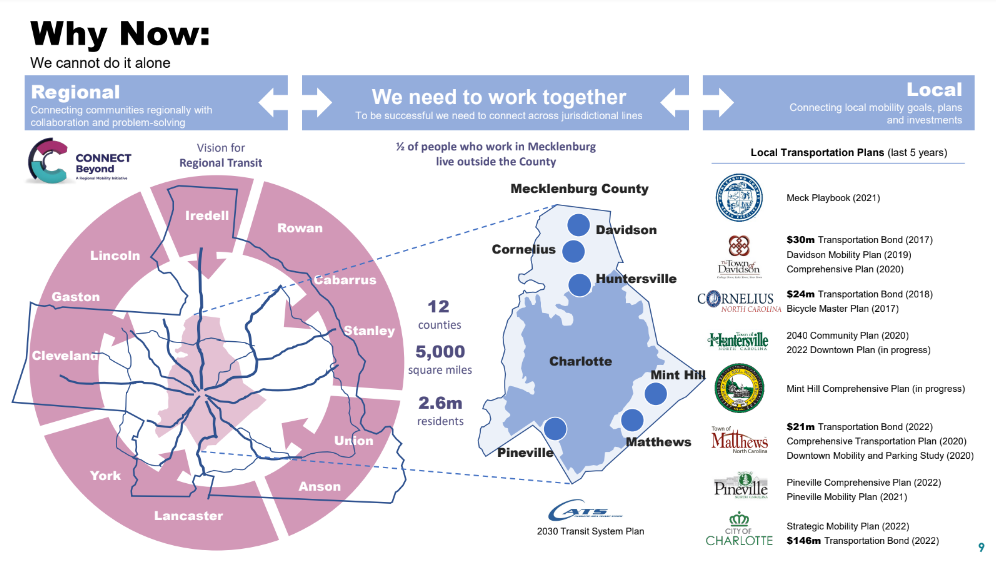
Thanks for reading!
As a nonprofit, community support is essential for us to keep doing what we do — including providing free articles like this. If you found this article helpful, please consider supporting Sustain Charlotte so we can continue advocating for a better future and working with residents, neighborhood organizations, government agencies, nonprofits, and businesses to solve the most critical challenges to Charlotte’s long-term social, economic, and environmental health.
Want to stay in the loop? Subscribe to our free, weekly newsletter and follow us on Twitter, Facebook, and Instagram.
